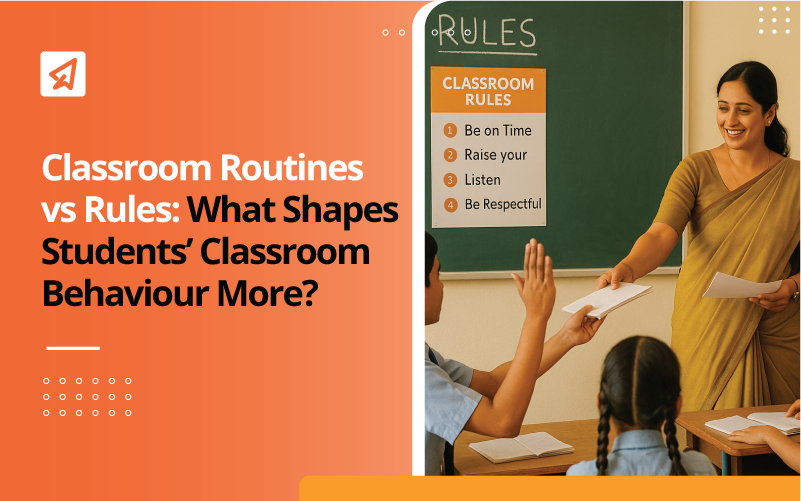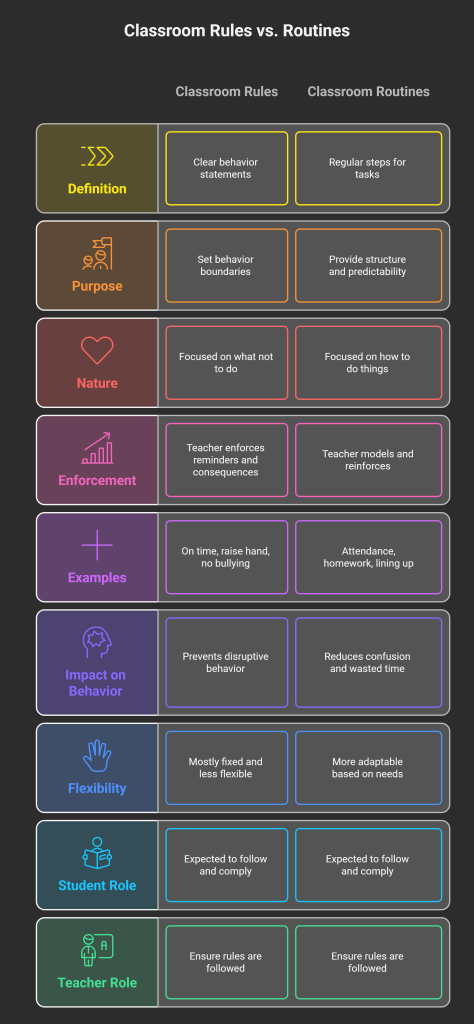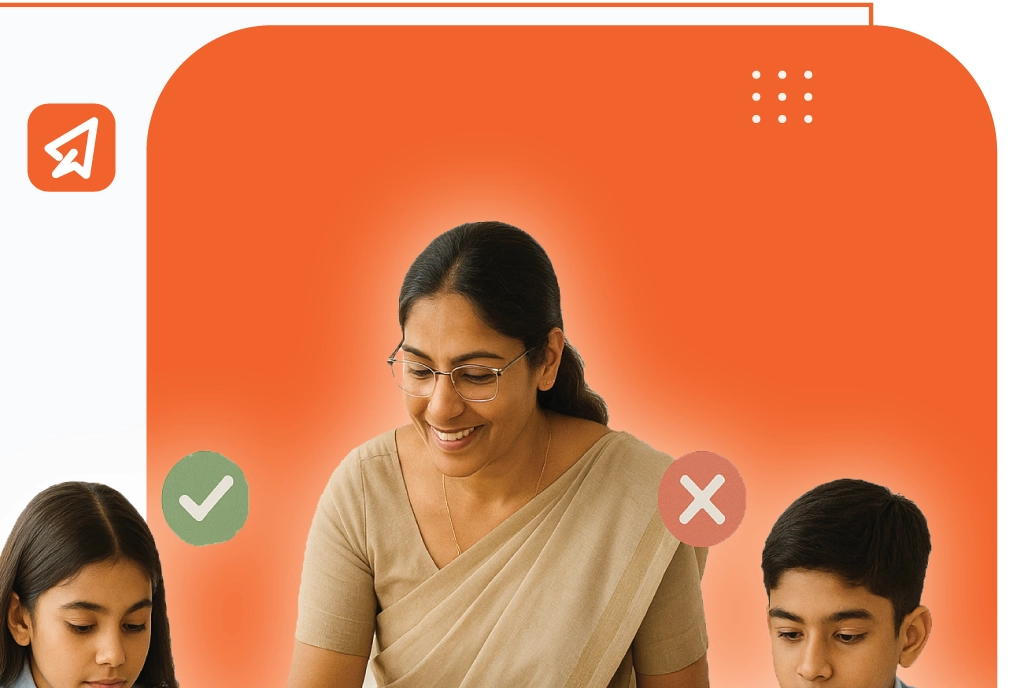Classroom Routines vs Rules: What Shapes Students’ Classroom Behaviour More?

Creating a positive learning environment is one of the biggest priorities for schools today. While rules set the boundaries of acceptable behaviour, routines establish the everyday flow of classroom activities. Both are essential, but which has a greater impact on shaping student behaviour? For school leaders and principals, understanding the balance between classroom rules and routines is key to improving discipline, enhancing student engagement, and ensuring smooth school management. This blog explores the role of each and how the right approach can transform classroom behaviour.
Key Takeaways:
- Classroom rules set boundaries for acceptable student behaviour.
- Classroom routines provide structure and predictability for daily tasks.
- Rules prevent disruptions, while routines reduce confusion and save time.
- Both are essential for building a respectful, organized, and engaging learning environment.
- The right balance between rules and routines leads to smoother classroom management and better student outcomes.
What Are Classroom Rules?
Classroom rules for students are clear instructions that outline how students should behave in class. They are simple, easy to understand, and help set the tone for respectful and organized learning. Unlike normal expectations, such as “be respectful,” rules are specific actions students can follow every day. For example, instead of saying “be responsible,” a rule might be “finish your homework on time.”
Rules give students a clear picture of what is allowed and what is not, which makes the classroom more focused, calm, and ready for learning.
Examples of Classroom Rules
- Come to class on time: This ensures lessons start smoothly without interruptions.
- Bring all required materials (books, notebooks, stationery) every day: Ensures students are prepared to learn.
- Raise your hand before speaking: Keeps discussions respectful and organized.
- Follow the teacher’s instructions the first time: Helps the class move forward without delays.
What Are Classroom Routines?
Classroom routines are the predictable, step-by-step procedures students follow for everyday tasks. These are the small actions that become second nature over time, like how you enter the class, turn in homework, or move between activities. Unlike rules, which say what behavior is expected, routines show how things happen smoothly and efficiently. According to Double Check Coaching, routines reduce disruptions, help transitions run more smoothly, and free up instructional time by establishing consistent expectations for common events.
Examples of Classroom Routines
- Morning Attendance: students answer roll call or mark their presence digitally at the start of the day.
- Homework Collection: students place homework in a designated tray or hand it in as soon as class begins.
- Lining Up: students line up quietly before entering or leaving the classroom.
- Morning Assembly: students gather at the same time every day for prayer, announcements, or activities.
Classroom rules vs routines
Look at the table below to understand the clear difference between classroom rules and routines.
| Aspect | Rules | Routines |
|---|---|---|
| Definition | Clear statements about how students must behave. | Regular steps students follow for everyday tasks. |
| Purpose | Set boundaries for acceptable behavior. | Provide structure, stability, and predictability. |
| Nature | Focused on what not to do and the consequences if rules are broken. | Focused on how to do things smoothly and consistently. |
| Enforcement | The teacher enforces reminders and consequences. | Teacher models and reinforces through practice. |
| Examples | Come to class on time, raise your hand to speak, and no bullying. | Morning attendance, submitting homework, and lining up for lunch. |
| Impact on Behavior | Prevents disruptive behavior by setting limits. | Reduces confusion and wasted time by creating smooth routines. |
| Flexibility | Mostly fixed and less flexible. | More adaptable based on class needs. |
| Student Role | Students are expected to follow and comply. | Students are expected to follow and comply. |
| Teacher Role | Ensure rules are followed and apply consequences if needed. | Ensure rules are followed and apply consequences if needed. |

Benefits of Classroom Rules
- Maintaining Order and Discipline: Rules help keep the classroom organized, reducing disruptions and creating a safe space for learning.
- Encouraging Respect: They promote respectful interactions between students and teachers, ensuring everyone feels valued.
- Instilling Responsibility: Following rules teaches students to take responsibility for their actions and choices.
- Promoting Fairness: Rules ensure equal treatment for all students, creating a fair and just classroom environment.
- Building Self-Discipline: Over time, students learn to control their behavior and make positive decisions without constant reminders.
- Preparing for Real-world Situations: Classroom procedures and rules mirror societal expectations, preparing students to follow norms and adapt in the outside world.
Benefits of Classroom Routines
- Creates consistency: Students know what to expect every day, which builds a stable learning environment.
- Enhances behavior management: Clear routines lower behavioral issues because students understand the flow and expectations.
- Reduces classroom distractions: With set routines, there’s less chaos or confusion about next steps.
- Boosts focus and engagement: Predictable transitions help students stay on task rather than wondering what to do next.
- Simplifies lesson planning: Teachers can use routines as the backbone of scheduling, allowing them to focus more on content.
Balancing Rules and Routines for Effective Classroom Management
Finding the right balance between rules and routines is key to smooth classroom management. Rules set non-negotiable boundaries, while routines provide the daily flow that keeps things running without friction. When teachers model and consistently enforce just a few essential rules and support them with routines, students know what to expect. This balance reduces disruptions and builds an atmosphere where learning can flourish. For more guidance on building such systems, check out our insights on Classroom Management.
Both rules and routines play a vital role in shaping classroom behaviour. Rules set the boundaries for what is acceptable, while routines give structure to the daily flow of school life. Establishing classroom routines and rules creates an environment that is organized, respectful, and focused on learning. For school leaders and principals, the key is not choosing one over the other, but striking the right balance where rules guide discipline and routines support consistency. With effective planning and consistent practice, schools can build classrooms where students feel secure, engaged, and ready to learn.
FAQs
What is the difference between classroom rules and classroom routines?
Rules are non-negotiable behaviour expectations (e.g., “no bullying”), while routines are step-by-step procedures for tasks (e.g., “submit homework at class start”). Rules maintain discipline; routines ensure order and smooth lessons.
How do routines support behaviour management?
Routines make classrooms predictable, reduce confusion, and save time. Clear procedures for daily tasks minimize distractions, helping students focus and behave better.
How can teachers balance rules and routines effectively?
Teachers set a few clear rules for discipline and pair them with consistent routines for daily tasks. For example, “respect others” (rule) and “wait your turn to speak” (routine) guide behaviour while supporting learning.
What are some examples of classroom procedures and rules?
- Rules: Come to class on time, raise your hand before speaking, follow teacher's instructions, no name-calling or bullying.
- Routines: Morning attendance, turning in homework at the beginning of class, lining up quietly for assembly, transitioning smoothly between group activities.
Last Updated on November 4, 2025








